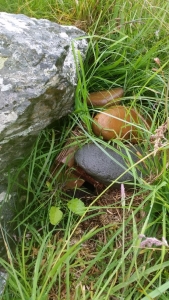As this is the first time I`ve updated this blog in 2016, I would be remiss not to begin by wishing a Happy New Year to all our members, their families and friends. I hope you all have a wonderful 2016!
I had hoped that maybe the weather would have made a resolution to be a bit less sodden and a bit more sunny once the calendar had turned and the days started to lengthen, but so far it has remained wild, wet, windy and true to form. When I see the devastation that has been caused in other areas of the country though, I can`t help but feel that we have got away lightly so far, and that maybe we would have a cheek to complain about the relatively superficial level of flooding that we have experienced up until now. In fact, the golf course remains almost entirely playable, with the main disruption confined to the areas around the 1st tee, the 9th fairway and the dune slack areas at 5, 7, 11 and 16. The links was of course routed with these dune slack areas uppermost in mind, for they are some of the most important ecological sites on the course map and therefore the holes themselves were directed away from the wetlands not only to keep golfers feet dry during the Winter months but also to protect the plants that they contained- plants that actually exist and thrive because of the regular and prolonged periods of flooding, rather than despite of it.
Does this mean that the period of flooding we are experiencing now will result in us enjoying an even larger than usual crop of spectacular wild flowers during the summer that will hopefully follow this miserable start to the year? Truth is, I actually don`t know, but I do know that it is our duty as custodians of the land to ensure that the correct movement of water around the course is maintained in order that the rare species that rely on these specific environmental conditions are allowed their optimum growing environment. We monitor this flow constantly, carefully checking areas that can easily become blocked and clearing water courses that are supposed to flow at a certain level in order to maintain the delicate natural balance. Fortunately, we are able to carry out this work without directly impacting any golfing areas on the course while we manage the waterways and outflows in order to ensure that unnecessary water is not held on the links that might negatively impact on the ecology and playability of the site in the future.

STRI Environment Awards
Some of you may remember that Machrihanish Dunes were recently nominated by the STRI as a finalist in their “Environmental Course of the Year” award. Four clubs across the U.K were given this prestigious honour, and myself and Craig Barr travelled down to the BTME exhibition at Harrogate to attend the awards. We were delighted to be surrounded by representatives from wide-ranging backgrounds- my naive anticipation was that we would be pitted against bigger clubs who may have had more resources available to instigate and carry through more ambitious projects than we could. This could not have been further from the truth and it was refreshing to be involved in an awards process where clubs were being judged purely on the merit of their application and their enthusiasm and ingenuity rather than how much marketing money they were willing to trade in return. The upshot of the evening was that we enjoyed fantastic food and company and met some people whose love of nature and the ecology of their golf course environments was truly inspiring, though sadly, we didn`t win.
In truth, despite my belief that our application was well written and that during the judge`s visit Craig and I showed off the natural beauty of our site and the fine work that my predecessors began, such as setting up many natural initiatives around the course to the best of our enthusiastic ability, we just hadn`t done as much as the winners did and to see the representatives from Pyecombe Golf Club in West Sussex accept their award with such pride more than made up for our disappointment at not coming away with the big trophy. Their initiatives were brilliant and they completely deserved their success. Their golf course looks stunning.

Fun Matters
One important facet of having a growing club membership is that it gives us a database of enthusiastic people to approach for feedback on what they enjoy about playing our course and where we could maybe improve the links in the future. When I speak to people who play regularly, the overpowering emotion I get from them is that they have great fun when they play at Machrihanish Dunes. That feeling of fun is a reaction that I would like to keep at the forefront of my mind as we move forward maintaining the course and making the occasional design tweak to improve Machrihanish Dunes. Although it was undoubtedly a daunting task to develop a patch of waterlogged, environmentally tainted grazing land into a world-class, full-size links golf course while only having planning permission to move 7 acres of sand, that restriction has left us with a site that retains all the idiosyncrasies that might easily have been bulldozed out had developers been granted permission to move material wherever they wanted to.
I have spent many years studying the topography of Britain`s historic seaside courses and I think there are very few examples of courses that have recently been built from scratch using heavy machinery that have not had much of the nonsense ironed out of them. I suppose it depends on what you deem to be fun, but for me the enjoyment of seeing a clever drive onto the backside of a hill rewarded with an extra 30 yards of run, or a misjudged pitch and run thwarted by thumping into a dastardly upslope that you had previously spotted and had intended to clear, cannot be matched by providing an unbroken vista of smooth bumps and hollows, carefully orchestrated to remove all potential unfairness from the equation, and to provide an unadulterated and manicured view for the lens of the fawning camera. Unfair bounces caused by links territory which has remained unsullied by bulldozer and excavator cause exasperation and amusement in equal doses but certrainly can never be described as dull. As a direct result of the “restrictions” that were placed on the developers of Machrihanish Dunes at the time of construction we have inherited a course that is brilliant fun to play for that exact reason. We know that we have plenty of scope to improve the golfing experience further without in any way compromising the environmental integrity of the site, and that there is a long way to go before the links can be spoken of in the same breath as some of the absolute classics that I made mention of earlier, but if people are choosing to play golf here specifically because they are having fun then the developers should be genuinely proud of having created something that in this modern era is very rare.

Please keep offering opinion and letting us know what you think- your input is very important to us. If there is any specific area on the course that is negatively impacting your enjoyment then we want to hear about it. It may well be something that we have in our plans to develop in the future, but it could just as easily be something we have missed altogether- it is easy to develop a one-dimensional outlook when working on a golf course that you see every day, and it is our belief that the end product can only benefit from more people bringing ideas to the table.
I hope you enjoy your golf in March and that maybe, just maybe we might see a glint of warm sunshine as the days get longer and we head into Spring!
Simon Freeman
Head Greenskeeper
Mach Dunes Golf Club

